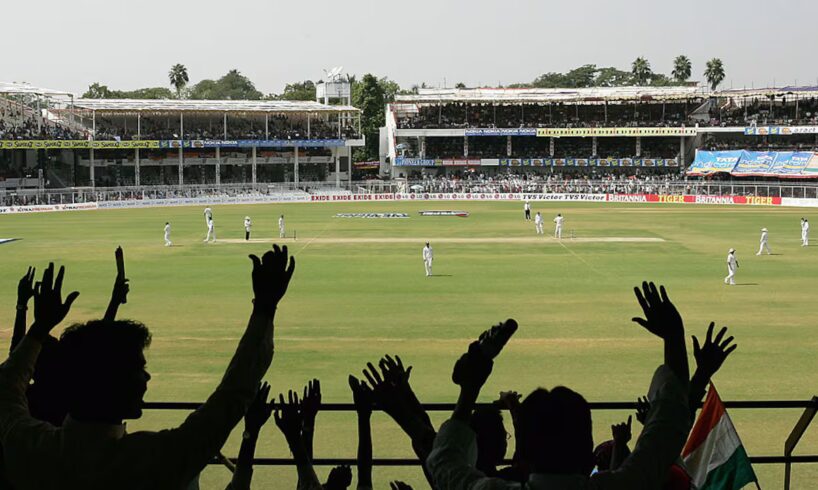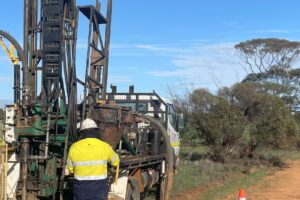
Instead of calling off the game – as would be expected today – the authorities decided to carry on, later claiming they feared there would be riots in the crowd if it was abandoned.
Reflecting on the incident three decades on, Black Caps all-rounder Dion Nash said players and management were left “completely in the dark” until after the game had finished.
“It was a crazy time to play cricket in India,” Nash told the Herald.
“It was a maxed-out crowd. It wasn’t one of the main areas, so they didn’t get cricket all the time. There were people hanging from the rafters just to watch the game.”
Nash says he remembers seeing smoke and a large commotion in the crowd, “but nothing happened of it”.
Vidarbha Cricket Association Ground hosting the 1995 ODI between the Black Caps and India. Photo / YouTube
“Everyone just kept carrying on cheering and the game carried on. There were no ambulances that were visible to us from the field, the crowd didn’t stop in silence.
“There was none of what you’d expect if something like that had happened, and so we just carried on quite obliviously and played the game.”
After the Black Caps bowled India out for 249 – winning by 99 runs – Nash said there was a line of army and police personnel shooing players from both teams to the changing rooms.
“That wasn’t that unusual with the crowds like that, but they were really aggressively pushing us in, which was unusual.”
He said when the team got into the changing room, their gear bags were already packed and they were rushed out of the ground – still wearing their cricket whites – to a bus waiting to take them away.
The Indian side was loaded on to the same bus.
“It wasn’t until we were on the bus and away that we were told what was going on.
“The people at the ground explained that their fear was if they called the game off, there would be rioting and more people would die. But they were also fearful that once people knew at the end of the game what had happened, people would riot and then potentially we wouldn’t get out of there because we’d carried on.
Black Caps allrounder Dion Nash. Photo / Photosport
“I remember there was a bit of anger in the squad because we weren’t given any information or choice at all … [They were] playing with our lives too a little bit.
“Thirteen people had lost their lives; that’s a significant event. What were we doing playing cricket?”
Nash said there was often a lot of commotion whenever the Black Caps toured India during that time of year, with spectators letting off firecrackers and lighting fires in the stands.
“It was full on. Sometimes you couldn’t hear each other in the middle.”
Former Black Caps fast bowler Danny Morrison said players initially thought the disturbance in the crowd was due to fans trying to sneak into the small, but packed-out stadium.
“It was very difficult to know what was really going on. There was some commotion and a bit of a ruckus. We thought it was about too many people trying to get in who didn’t have tickets, or had black market tickets and there was just a massive disturbance.
“It stopped the game for some time … they really wouldn’t quite say [what happened] at the time.”
Former Black Caps fast bowler Danny Morrison. Photo / Photosport
He said the section of the grandstand collapsed at the back of the stadium, so players were unable to see any debris come tumbling down.
“Obviously the cement hadn’t sealed, hadn’t dried out. They rushed it and sadly it collapsed. We weren’t to know that, that was the freaky thing.
“I think the authorities were probably quite concerned that would cause a riot and a real nasty incident to get out of there safely. You’ve heard horror stories where they [fans] would just burn sections of the stadium and, you know, if the thing went up you’d be in trouble because of the stampede of people.
“I think more than anything you just felt quite sad for people there and the fans that get subjected to what they have to view a game in and their surroundings.”
The Herald ran a small Reuters story on the front page the next day headlined ‘Cricket spectators killed watching NZ beat India’.
But there was no other mention in the following days, with the coverage more focused on the New Zealand side earning a day off before the sixth and final ODI in Brabourne three days later.
On the Cricinfo match page, the stadium collapse is only mentioned as a third bullet point under ‘Astle dropped by Tendulkar’ and ‘Tendulkar hit 20 runs off one over from Morrison’.
One Kiwi who was less in the dark was former Black Cap turned commentator Ian Smith, who was calling the game alongside India’s Harsha Bhogle.
Smith said spectators were trying to get out of the stand during a break in play, putting pressure on the building.
“I remember the weird feeling in the commentary box. Disbelief from some. Others not so distressed,” Smith said.
“I assumed that it would mean the end of the match, but the theory apparently was that there would be a bigger commotion and threat if the game was called off. Staggering really, but I guess a reflection on the importance of cricket in relation to other things.”
In the end no one was held accountable, and the ground held a Cricket World Cup game a few months later. It’s now largely used for domestic cricket and hasn’t held an international since 2007.
Charges were initially filed against the then VCA bosses, architect, and the builder, but a Times of India report in 2008 claimed nobody was ever prosecuted or asked to pay damages.
“The tragedy that remains cricket world’s biggest is all but forgotten now,” the Times of India wrote.
“The relatives of victims… are still to get justice. Nobody has been asked to pay damages. Nobody has gone to jail for either poor design or bad construction of the parapet.”
Benjamin Plummer is an Auckland-based reporter for the New Zealand Herald who covers sport and breaking news. He has worked for the Herald since 2022.





